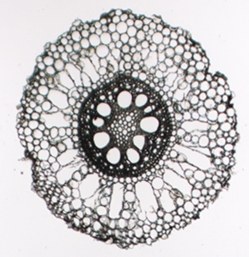
Root tissue section
Microtomy and Microscopy
Anatomy is the study of the structure of living organisms, while morphology is the study of an organism's form and the development of that form. In biological organisms, there is usually a relationship between form and function, reflective of designs that serve a particular purpose. For instance, the anatomy of the root system reveals its various roles in storage, anchorage, and the acquisition and transport of nutrients and water. Because of this, the study of anatomy has much to tell us about the physiology of plants.
Plant anatomy and morphology are critical components of nutrient acquisition and transport. Radial, or concentric, arrangement of tissues within the root determines patterns and rates of nutrient transport from the soil to the vascular tissue. The presence of certain features, such as the casparian band in the endodermis, allow passage of needed compounds and prevent uptake of toxic substances. Patterns of root growth determine when and where roots encounter nutrients. The amount of biomass underground, compared to the aboveground biomass, gives us an idea of how much the plant is "spending" on its root system. If it is spending a lot, this might mean that it is growing a lot or is having a hard time getting what it needs to grow.
The Roots Lab uses primarily laser ablation tomography (LAT) to image root anatomy. See our LAT methods section for more information.
on Plant Anatomy, Morphology and Microscopy

